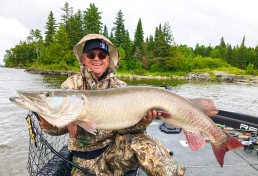Fall ‘Lunge Locales
SHARE THIS POST
Muskie expert Joe Bucher fishes progressively deeper as fall heads toward winter.
Muskie location throughout fall can vary greatly—just like the weather. For example, muskies tend to be shallower while water temperatures hold above the 50-degree range, staging in a wide range of habitat including weeds, wood, rocks, sand and even open water. Remaining stands of healthy weeds are one of the very best spots to start. The odds of finding a muskie in any weed bed steadily increase as the annual die-back of weed growth accelerates isolating muskies to select healthy standing clumps.
However, don’t be surprised to find a good fish or two on shallow rock humps, either. Some of my biggest fall muskies have come from shallow rock outcroppings. Any rock hump or point immediately adjacent to a once-productive weed bed is likely to hold the highest potential. Another high-percentage fall rock hump is one that is adjacent to a rocky point.
Early October often signals the last time of the year when shallow, mid lake rock humps produce with any regularity. Smallmouths, perch and walleyes are apt to school up on such areas just prior to the first real major arctic fronts moving through. Muskies, of course, will be stationed nearby, ready for any easy fall lunch. As soon as the real cold fall weather arrives, mid-lake humps seem to lose their punch. Steep, rocky shorelines then begin to turn on at this time.
Shallow rocks are bound to be particularly good on chilly, dry, bluebird fall days right after a dark, misty cold front has passed through. The intense sunlight seems to draw fish of all species to these rocky outcroppings; muskies are no exception. Never overlook shallow rock bars jutting off points when a cold, fall blue-sky situation arrives. Muskies seem to appear on these spots out of nowhere whenever these conditions develop.
Are you enjoying this post?
You can be among the first to get the latest info on where to go, what to use and how to use it!
Fingers of deeper rocks and boulders jutting out from land points are predictably deadly. Yet less-obvious rock/boulder fingers protruding off large sandy or weedy flats can be the real super fall hotspots. Once nearly impossible to find, rock and boulder fingers off flats show up easily on modern electronics. Quite honestly, when I find rock and boulder fingers in the 8- to18-foot range in the fall, they are often my most productive as well as most consistent muskie spots on most fall outings.
Wood in many forms is one more key cover element that holds fall muskie potential, and it increases in value as water temps dip. Usually, the best fall wood is positioned near deeper water. October muskies particularly like wood on flats and bars. By late fall, wood on sharp breaks becomes the ticket. Find a sunken log, brushpile or a man-made fish crib on a sharp break and it’s a good bet it will be a late fall muskie hotspot. Modern-day sonars that include side imaging now enable anglers to easily spot isolated sunken timber of any kind along flats, reefs and breaklines.
Finally, as the calendar turns to November and frigid, cold, icy waters, wood and rocks on deep bottom contour transitions become the key to success. Slow way down and pick small select areas near the deepest waters in the basin. Slowly zig-zagging your way in and out from the deep silt basin to hard-bottom transitions, searching for isolated deep wood or boulders. Muskies are apt to be in these locales right through ice-up.
Thinking of trying a new location or different fish species this year, you’ll find plenty of information in every issue of MidWest Outdoors, available by subscribing on our website.
MWO
SHARE THIS POST
You may also like...
Nothing found.
Did you enjoy this post?
You can be among the first to get the latest info on where to go, what to use and how to use it!
Joe Bucher
Joe Bucher is a Freshwater Fishing Hall of Fame Legendary Angler, book author, lure designer and host of Fishing with Joe Bucher TV series.
